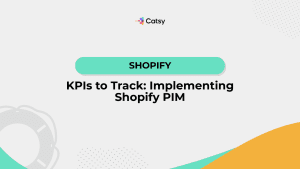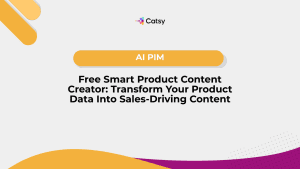Fashion E-commerce HubSpot Setup: PIM Connector Implementation Guide
Complete PIM Connector Implementation Guide
- Elizabeth Byrd
- October 3, 2025
- 2:31 pm

Table of Contents
What You'll Learn:
- How to plan and execute a complete fashion e-commerce HubSpot setup with PIM integration in just 6 to 12 weeks
- Why fashion brands need specialized data mapping for size matrices, seasonal collections, and color variants
- How to configure automated workflows that respond to inventory changes and seasonal campaigns
- Which testing protocols ensure your fashion catalog displays correctly across all HubSpot touchpoints
- How to optimize performance and measure ROI from your integrated fashion e-commerce HubSpot system
You’ve made the decision to integrate your fashion e-commerce operation with HubSpot. Congratulations, you’re on your way to a more streamlined operation!
But… where do you start? Unlike a business to business setup, a fashion e-commerce implementation with HubSpot is complex. Special handling for these complexities is essential; your legacy systems likely can’t support your seasonal inventory, size and color matrices, and your intricate product relationships.
The timeline to implement a PIM in fashion can vary from a few weeks to several months, depending on your catalog complexity. No matter the size of your catalog, though, you’ll need proper planning. This will ensure that your setup time maximizes the 65 percent reduction in time to market and the 30 percent decrease in product return rates that successful retailers achieve.
The key: Following a systematic approach that addresses fashion’s unique requirements while leveraging HubSpot’s powerful automation capabilities.
1. Pre-Implementation Planning: Fashion E-commerce Requirements
Define Your Fashion Catalog Complexity
Begin with a thorough audit: Before you touch any system, document your existing product structure.
Fashion-specific considerations:
- Product variations: Colors, sizes, materials, seasonal collections
- Inventory patterns: Fast-moving trends versus classic items
- Channel requirements: Website, marketplaces, social media, physical stores
- Seasonal cycles: Collection launches, clearance periods, promotional calendars
Industry benchmark: Fashion brands typically manage product catalogs in an $1.84 trillion global market with 2.81 percent annual growth. As you’d imagine, this can make accurate catalog management critical!
Assess Current System Landscape
Essential integrations audit:
- E-commerce platform: Shopify, BigCommerce, Magento, WooCommerce
- ERP system: Inventory, purchasing, financial data
- Digital assets: Product photography, videos, lookbooks
- Marketing tools: Email platforms, social media, advertising accounts
Critical question: 80 percent of consumers prefer to find brand information on mobile devices. Make sure that your planned setup supports your customers’ mobile-optimized experiences.
Data Ownership and Quality Standards
Establish clear ownership:
- Product information: Merchandising team responsibility
- Pricing and inventory: Operations team oversight
- Marketing content: Marketing team creation and approval
- Digital assets: Creative team management
Quality benchmarks: Define acceptable data completeness levels… most successful fashion brands require over 90 percent product information completeness before a successful launch.
Timeline and Resource Planning
Realistic implementation phases:
- Phase 1 (Weeks 1 to 2): Setting up your foundation and preparation of your data. Clean data is essential to integration success, so be thorough!
- Phase 2 (Weeks 3 to 6): Configuration of PIM connector and initial data mapping should be completed in this time.
- Phase 3 (Weeks 7 to 10): This phase is for testing, validation, and establishment of workflows
- Phase 4 (Weeks 11 to 12): Prepare to launch! Remember that ongoing training of your teams is critical for your long-term success.
Resource requirements: Plan to support your teams with dedicated project management, tech support, and user training across each of your departments. Consider their feedback, too – ease of use for your teams is critical to your success.
2. HubSpot Foundation Setup for Fashion Brands
Commerce Hub Configuration
Modern advantage: HubSpot’s Commerce Hub is designed for fast implementation in days, not months with AI-powered CPQ that works out-of-the-box.
Fashion-specific setup:
- Product hierarchies: Collections → Categories → Individual items → Variations
- Seasonal structures: Spring/Summer, Fall/Winter collection organization
- Price management: MSRP, wholesale, promotional, clearance pricing tiers
- Inventory tracking: Size-specific availability, pre-order capabilities
Custom Properties for Fashion Data
Essential fashion properties:
- Size information: Size charts, fit guides, international conversions
- Material details: Fabric composition, care instructions, sustainability certifications
- Style attributes: Color families, pattern types, seasonal relevance
- Collection metadata: Launch dates, designer attributions, trend classifications
Technical note: Create dropdown properties for standardized attributes like colors and sizes to ensure data consistency.
Contact and Company Setup
Fashion customer segmentation:
- Purchase behavior: Seasonal shoppers, trend followers, classic buyers
- Size preferences: Track preferred sizes for personalized recommendations
- Brand affinity: Designer preferences, price point comfort levels
- Channel preferences: Online-only, omnichannel, store pickup preferences
B2B considerations: If serving retailers, set up company-level properties for wholesale pricing, minimum orders, and territory management.
Marketing Hub Preparation
Campaign structure setup:
- Seasonal campaigns: Collection launches, holiday promotions, end-of-season clearance
- Product lifecycle campaigns: New arrivals, restock notifications, discontinuation alerts
- Customer lifecycle campaigns: Welcome series, loyalty programs, win-back sequences
- Content organization: Create folder structures for different collections, seasons, and campaign types to maintain organization as content volume grows.
3. PIM Connector Configuration and Data Mapping
Choosing the Right PIM Connector
Best HubSpot PIM integration considerations:
API-first architecture: Ensure real-time data synchronization for inventory and pricing updates Fashion-specific features: Size matrix support, color variant management, seasonal tagging Scalability: Handle growing product catalogs without performance degradation
Digital Asset management: Support for high-resolution images, videos, and documentation
Data Mapping Strategy
Critical fashion data flows:
Product information:
PIM → HubSpot Product Properties
– SKU → Product ID
– Product Name → HubSpot Product Name
– Description → Product Description
– Category → Product Type
– Collection → Custom Property: Collection
– Season → Custom Property: Season
Inventory integration:
PIM Inventory → HubSpot Custom Properties
– Available Quantity → Stock Level
– Size Availability → Size Matrix Property
– Restock Date → Custom Property: Expected Restock
Pricing synchronization:
PIM Pricing → HubSpot Pricing
– MSRP → List Price
– Wholesale Price → Custom Property: Wholesale
– Current Promotion → Sale Price
Automated Workflow Configuration
Inventory-triggered workflows:
- Low stock alerts: Notify sales team when popular items drop below threshold
- Restock notifications: Automatically email interested customers when items return
- Seasonal transitions: Update campaign messaging as collections change
Marketing automation:
- New arrival sequences: Welcome campaigns for fresh inventory
- Price change notifications: Alert customers about sales and promotions
- Collection launches: Orchestrated campaigns across email, social, and ads
Digital Asset Management Integration
Visual content synchronization:
- Product images: Primary, alternate angles, lifestyle shots
- Size guides: Technical diagrams and fit information
- Care instructions: Washing, storage, and maintenance details
- Brand assets: Logos, campaign imagery, seasonal graphics
Catys’s AI-powered features can automatically generate product descriptions, SEO metadata, and campaign copy based on synchronized product attributes, reducing manual content creation time.
4. Testing and Validation: Ensuring Fashion Catalog Integrity
Data Accuracy Validation
Pre-launch testing checklist:
Product information accuracy:
- Size charts display correctly across all product variations
- Color representation matches actual products in images
- Pricing consistency across all channels and customer segments
- Inventory levels update in real-time between systems
Cross-platform consistency: Verify product information appears identically on website, email campaigns, and social media integrations.
Workflow Testing Scenarios
Seasonal transition testing:
- Collection launches: Verify new products automatically appear in relevant campaigns
- Inventory changes: Test low stock and restock notification workflows
- Price updates: Confirm promotional pricing flows through all touchpoints
- Campaign triggers: Ensure seasonal campaigns activate based on product attributes
Customer journey validation: Test complete purchase paths from product discovery through checkout and follow-up communications.
Performance and Integration Testing
System performance benchmarks:
- Page load speeds: Product pages should load in under 3 seconds
- Data synchronization: Updates should appear across systems within 15 minutes
- Search functionality: Product filtering and search work correctly with new data structure
- Mobile optimization: All product information displays properly on mobile devices
Integration stress testing: Verify system performance during high-traffic periods like flash sales or collection launches.
User Acceptance Testing
Team-specific testing:
- Merchandising team: Can easily add new products and update existing information
- Marketing team: Campaign creation works smoothly with product data
- Customer service: Access to complete product information for support inquiries
- Sales team: Proper access to wholesale pricing and inventory levels
Documentation creation: Develop user guides and troubleshooting procedures for each team’s specific needs.
5. Launch and Optimization: Maximizing Fashion E-commerce Performance
Soft Launch Strategy
Phased rollout approach:
- Internal testing (Week 1): Team members test all functionality
- Beta customer group (Week 2): Limited customer group tests purchase flows
- Partial catalog (Week 3): Launch with subset of products to monitor performance
- Full launch (Week 4): Complete catalog and customer base activation
Success metrics: Leading fashion retailers achieve 65 percent reduction in time-to-market and 30 percent decrease in product return rates with properly implemented systems.
Performance Monitoring Setup
Key performance indicators:
- Conversion rates: Track by product category and seasonal collection
- Cart abandonment: Monitor for issues related to product information gaps
- Search performance: Measure product discovery effectiveness
- Customer satisfaction: Track return rates and support ticket volume
Automated monitoring: Set up HubSpot dashboards that display critical metrics and alert teams to performance issues.
Ongoing Optimization
Monthly optimization tasks:
- Product data quality: Review completeness and accuracy metrics
- Campaign performance: Analyze seasonal campaign effectiveness
- Customer feedback: Address common questions through improved product information
- System performance: Monitor load times and integration reliability
Seasonal optimization:
- Collection launches: Refine processes based on previous season performance
- Inventory planning: Use historical data to improve stock level predictions
- Campaign timing: Optimize launch timing based on customer engagement patterns
ROI Measurement and Reporting
Financial impact tracking:
- Increased conversion rates from better product information
- Reduced return rates due to accurate sizing and descriptions
- Improved operational efficiency through automated processes
- Enhanced customer lifetime value from better personalization
Key Takeaways
- Systematic planning reduces implementation time: Proper fashion catalog analysis and system mapping enables 6-12 week implementation vs. months of trial-and-error
- Fashion-specific configuration drives results: Specialized setup for size matrices, seasonal collections, and color variants achieves 65 percent faster time-to-market
- Automated workflows scale operations: Inventory-triggered campaigns and seasonal transitions reduce manual work while improving customer experience
- Testing prevents costly mistakes: Comprehensive validation ensures accurate product information across all touchpoints before launch
- Continuous optimization maximizes ROI: Monthly performance reviews and seasonal adjustments maintain competitive advantage in fast-moving fashion markets
FAQs:
What is fashion e-commerce HubSpot setup?
A specialized HubSpot configuration that’s designed for fashion brands with complex catalogs. This may include seasonal collections, size or color matrices, and inventory-driven marketing automation. A PIM connector integration enables real time sync between your PIM and your marketing campaigns.
How can PIM connectors help fashion e-commerce brands with HubSpot?
Your PIM connectors automate the data flow between your PIM and HubSpot. This enables real-time inventory updates, personalized recommendations, and, most importantly, consistency across each and every one of your customer touchpoints.
Are there cost-effective HubSpot PIM solutions for emerging fashion brands?
Yep! Cloud-based PIM solutions offer tiered pricing that is suitable for growing fashion brands. Implementation usually takes between six and 12 weeks, but you’ll see immediate benefits in your operational efficiency and your campaign effectiveness. ROI will typically appear within the first seasonal cycle due to improved conversion.
How quickly can fashion brands see results from integrated HubSpot setup?
Most fashion brands will see immediate operational improvements, and will see measurable results within three to six months. Benefits may include a 65 percent reduction in time to market for new products, a 30 percent decrease in returns, and a vastly improved, targeted marketing campaign.
Is HubSpot PIM integration worth it for seasonal fashion businesses?
Absolutely! Seasonal businesses benefit most from integration because manual coordination becomes exponentially complex during peak periods. Automated workflows ensure consistent execution during collection launches while freeing teams to focus on creative strategy and customer experience when demand peaks.
Elizabeth Byrd
Consider multi-store architecture when you are facing significant regional product variations. Complex compliance requirements and distinct customer segments should also be considered.
Typically, manufacturing businesses will benefit from multi-store approaches. This is especially true if you’re serving markets with different safety standards or regulatory requirements. Remember, too, that business-to-business and business-to-consumer customers will have fundamentally different purchasing processes.
Effective inventory management requires integration between your stores and your legacy systems. This usually involves middleware solutions.
You can synchronize your stock levels, coordinate fulfillment, and manage your regional allocation strategies. The key lies in maintaining real-time visibility across each of your channels while enabling flexible fulfillment.
The primary challenges you may face include management of safety standards, tech documentation, and environmental regulations. Proper customs and import documentation may also come into pay.
Each market may require different certifications, testing procedures, and ongoing compliance monitoring, and these must be integrated into your multi-store operations.
The primary challenges you may face include management of safety standards, tech documentation, and environmental regulations. Proper customs and import documentation may also come into pay.
Each market may require different certifications, testing procedures, and ongoing compliance monitoring, and these must be integrated into your multi-store operations.





